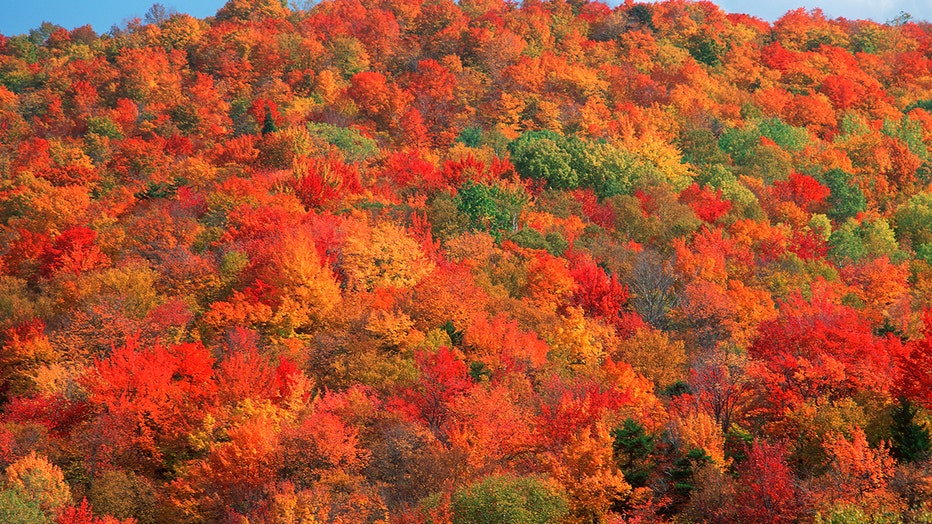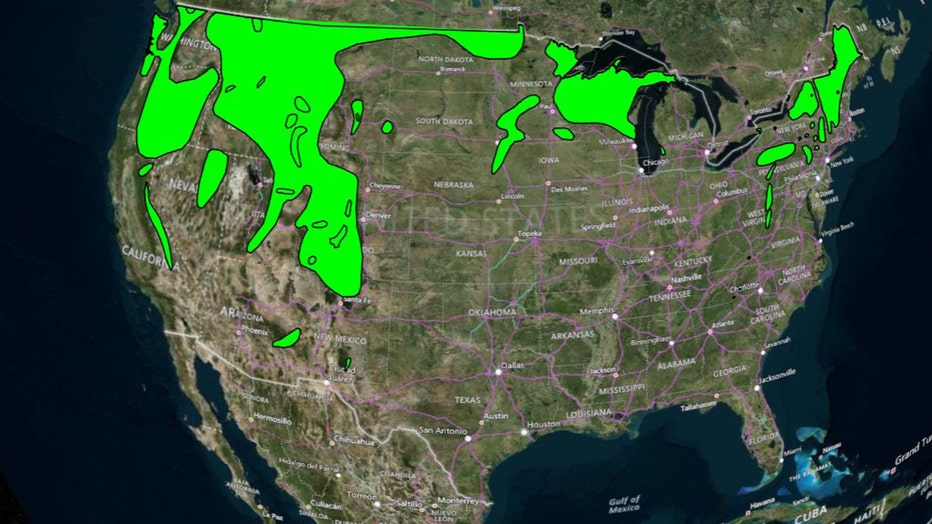Leaf color tracker: Here’s when fall foliage will peak across US in 2024
The fall season is almost upon us (and meteorological fall is already here), but temperatures won’t be the only thing changing across the country.
The transition of temperatures typically coincides with the beginning of fall foliage, which means spectacular views of red, maroon, yellow and orange leaves.
But when will trees start showing off their beautiful earthy hues?
When will fall foliage peak?
Fall foliage is highly contingent on the location and weather conditions in the weeks, and even months, before the height of the season.
In fact, in some areas, this can start as early as September, and most locations will peak in either October or November.

Autumn foliage in Vermont (Credit: Joe Sohm/Visions of America/Universal Images Group via Getty Images)
"Currently, all signs are pointing to an earlier peak along the entire east coast, down from New England to the Carolina mountains," said Kyle Cotner, the founder and owner of The Foliage Report. "This is because of the previous weather conditions from the summer and currently in September. The color change may slow down a bit due to the higher temperatures forecasted for the next few weeks but still on for a week earlier than normal."
For the Midwest and West, Cotner said he is predicting a "more traditional timing" of peak fall color, but noted that wildfire smoke can block sunshine which may cause the leaves to lose chlorophyll quicker, thus showing colors sooner. You can see his fall color map here.
Which states will see best fall foliage in 2024?
Cotner said to keep an eye on the New England region and West for its fall foliage in 2024.

Foliage report as of Sept. 16, 2023. Green indicates "low color." (Credit: Kyle Cotner, The Foliage Report)
"New England is on pace for an incredible fall foliage year," Cotner continued, adding, "Which is a complete 180 from last year since the region received way too much moisture from August-October."
He also suggested looking out West to Utah, Colorado and California to have a "fantastic year."
But, if you’re wondering when your region will peak with its festive autumn tones, here’s what you can expect, according to the Smoky Mountains’ Fall Foliage Prediction Map.
Fall color map predictions
According to the Smoky Mountains' leaf color map, colors will start to peak as early as Sept. 30 until the week of Nov. 18.
Week of Sept. 30: Colors may start to peak in the Northern states, specifically in portions of Idaho, Montana, North Dakota, Maine, Vermont and the upper peninsula of Michigan. The Rockies in Colorado may also hit their peak during this week.
Week of Oct. 7: Colors may peak in the New England region and in the Upper Midwest. Maine, New Hampshire, Massachusetts, Vermont, New Jersey, Massachusetts, along with Northern New York, Connecticut and Rhode Island may also see peak colors. The upper Midwest and Eastern Michigan, including Detroit, may also see its peak.
Week of Oct. 14: By this point, most of the Northeast may have hit its peak foliage. This now also includes New York City and much of New Jersey and Pennsylvania. Much of Washington State may also see peak or near-peak activity. By this point, Cotner said peak foliage may occur in Northern Arizona and Taos, New Mexico.
Week of Oct. 21: By October 21, more of the West and East coast, along with the Mountain Region, may start to experience peak foliage. This includes sections of Indiana, Ohio, Oregon, Colorado, Delaware, Maryland and D.C. According to Cotner, Western North Carolina may also hit its peak.
Week of Oct. 28: By Oct. 28, most of the North and Northeast should be past their peak. Parts of Virginia, North Carolina, Kentucky, Nevada, Utah and Arizona may see its peak fall colors.
Week fo Nov. 4: Most of the peak foliage is expected to occur this week in Western and Southwestern states such as California, Southern Arizona, New Mexico, along with Iowa, Missouri, Kansas, Tennessee and South Carolina.
Week of Nov. 11: Sections of the South may be the only states that have not passed their peak by this point in the year. Sections of Oklahoma, Arkansas, Mississippi, Alabama and Western Texas are expected to hit their peak colors.
Week of Nov. 18: The remaining states that should hit their peak colors include Eastern Texas, Louisiana and Florida.
See the full map tracker here.
What is fall foliage?
While the color of leaves depends on chlorophyll, weather extremes can play a significant role in how magnificent the sights are during autumn.
According to FOX Weather, chlorophyll is a pigment that helps give leaves their color. The chemical compound helps the trees create their own food through photosynthesis, which converts sunlight into chemical energy.
"Most folks think that green is the natural color of many leaves, but it is not," Cotner explained. "Many leaves have a natural color of Red/Orange/Yellow but are masked up by chlorophyll's green. When the chlorophyll stops getting sunlight (which it feeds off of), it'll start to break down and the natural color of the leaves will be shown."
The lack of chlorophyll can help reveal the sought-after yellow, orange and red colors, which are usually bountiful during rainier periods.
What makes the best fall colors?
According to experts at the U.S. Forest Service, a combination of warm, sunny days and cool, crisp nights can help enhance the most vivid colors.
Nights must stay above freezing but get cold enough to prevent sugars from leaving the leaves.
RELATED: Watch: Moose enjoy festive fall dip in Colorado lake amid stunning autumn foliage
Areas that experience a wet spring during the growing season, normal summer weather and a fall that is drier and lacks warm overnight lows have the best potential to see brilliant colors.
Orange and yellow colors are present year-round in leaves, but green pigment from active chlorophyll prevents them from being visible.
The production of anthocyanins during the fall is responsible for the reddish and purple hues, which are dependent on the amount of sunshine, among other factors.
What can delay the changes in leaves?
Experts say a late arrival of spring or a significant summer drought can delay the onset of colors by several weeks.
The addition of significant cool spells or even tropical cyclones, especially along the Eastern Seaboard, can alter the season altogether and prevent the vibrant colors from making their appearance.
Droughts also have the effect of ending foliage quicker than in years with more precipitation.

